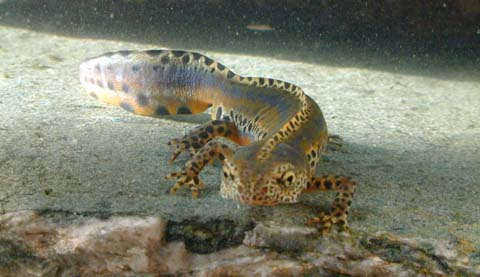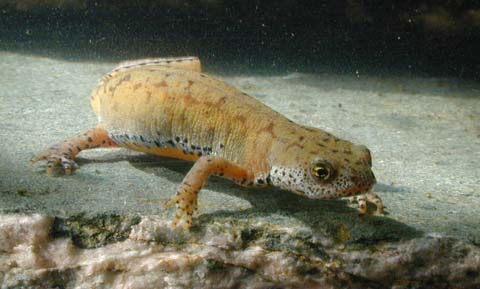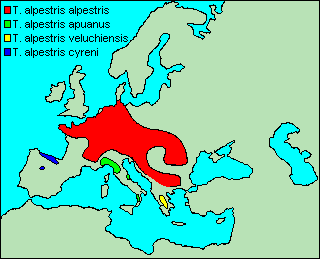
TRITURUS ALPESTRIS (=MESOTRITON ALPESTRIS): THE ALPINE NEWT

Male T. alpestris.

Female T. alpestris.


Mating behaviour: male shown in black, female in white. From Arntzen & Sparreboom (1989).
DESCRIPTION
The alpine newt growns to a size of around 10 cm., although females are larger than males. Both sexes have a dark grey, or grey-blue colouration, which may have subtle blotches or marblings in similar shades. The belly is unspotted (although the throat may have some spotting) and is yellow-orange to reddish. Breeding males have a whitish band with black spotting, running from the cheeks, along the lower side of the flanks, onto the cloaca. They also have a low straight crest which is also whitish with dark spots.
SUBSPECIES
T. alpestris has a large number of subspecies, some very restricted in range, some exclusively neotenous. Some of the forms with small ranges are not indicated on the map above.
T. a. alpestris
The nominate form is found over much of central Europe,
southwards to the Balkan peninsula, and east to the Ukraine.
T. a. apuanus
This subspecies is found in Italy (although some workers believe
the isolated southern Italian populations to be a separate
subspecies, T.a. inexpectatus), and south-eastern France.
T. a. cyreni
This form occurs in isolated populations in central and northern
Spain.
T. a. lacusnigri
This subspecies is restricted to the Lake Crno in Slovenia (not
indicated on the map above). This taxon is possibly extinct, due
to fish predation in the single lake it has been described from (Vogrin,
1996).
T. a. montenegrinus
This is an exclusively neotenous subspecies, found only in
Bukumirsko Lake, in Montenegro, in the former Yugoslavia (not
indicated on the map above).
T. a. piperianus
This subspecies is another neotenous form with a reduced range,
also restricted to Montenegro (not indicated on the map above).
T. a. reiseri
This subspecies is restricted to the Vranika mountains, in Bosnia
(not indicated on the map above).
T. a. serdarus
T. a. serdarus is another neotenous subspecies, also found
only in Montenegro (not indicated on the map above).
T. a. veluchiensis
T. a. veluchiensis occurs in the Veluchi mountains, in
central Greece.
REFERENCES
Arntzen, J. W. & Sparreboom, M., 1989. A phylogeny for the Old World newts, genus Triturus: biochemical and behavioural data. J. Zool., Lond. 219: 645-664.
Vogrin, N., 1996. An Overview of
the Herpetofauna of Slovenia. British Herpetological Society
Bulletin 58: 26-35.
